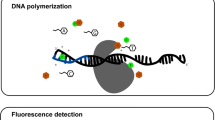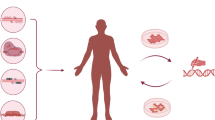Abstract
Infrared (IR) laser ablation was used to remove material from tissue sections mounted on microscope slides, with subsequent capture in a solvent-containing microcentrifuge tube. Experiments conducted with a 3200-bp double-stranded plasmid DNA template demonstrated IR-laser ablation transfer of intact DNA. The transfer efficiency and the molecular integrity of the captured DNA were evaluated using Sanger sequencing, gel electrophoresis, and fluorimetric analysis. The plasmid DNA was reproducibly transferred with an efficiency of 59 ± 3% at laser fluences of between 10 and 20 kJ/m2 at a wavelength of 3 μm. IR laser ablation sample transfer was then used to ablate and capture DNA from 50-μm-thick rat brain and kidney tissue sections. DNA was extracted from the captured material using five commercial DNA extraction kits that employed significantly divergent methodologies, with all kits recovering sufficient DNA for successful amplification by polymerase chain reaction (PCR). Four sets of primers were employed, targeting one region of the CYP 11b2 gene (376 bp) and three different regions of the Snn1g gene (298, 168, and 281 bp). The PCR results were not consistently reliable when using unpurified ablation samples; however, after extraction, all samples produced PCR products of the expected size. This work expands the sampling capabilities of IR laser ablation, demonstrating that DNA can be isolated from tissue samples for genomic assays. Due to the small size of the ablation regions (1 mm2), this technique will be useful for sampling discrete cell populations from tissue sections.

Infrared laser ablation transfer of intact DNA from a tissue section.




Similar content being viewed by others
References
Rodriguez-Canales J, Hanson JC, Hipp JD, Balis UJ, Tangrea MA, Emmert-Buck MR, et al. Optimal molecular profiling of tissue and tissue components: defining the best processing and microdissection methods for biomedical applications. Pancreat Cancer: Methods Protoc. 2013;61–120.
Hanahan D, Weinberg RA. Hallmarks of cancer: the next generation. Cell. 2011;144(5):646–74.
Harrell JC, Dye WW, Harvell DM, Sartorius CA, Horwitz KB. Contaminating cells alter gene signatures in whole organ versus laser capture microdissected tumors: a comparison of experimental breast cancers and their lymph node metastases. Clin Exp Metastasis. 2008;25(1):81–8.
Klee EW, Erdogan S, Tillmans L, Kosari F, Sun Z, Wigle DA, et al. Impact of sample acquisition and linear amplification on gene expression profiling of lung adenocarcinoma: laser capture micro-dissection cell-sampling versus bulk tissue-sampling. BMC Med Genet. 2009;2(1):13.
Rabien A, Kristiansen G. Tissue microdissection. Cancer Gene Profiling: Methods Protoc. 2016;39–52.
Moelans CB, de Weger RA, Ezendam C, van Diest PJ. HER-2/neu amplification testing in breast cancer by multiplex ligation-dependent probe amplification: influence of manual-and laser microdissection. BMC Cancer. 2009;9(1):1.
Hoefig KP, Heissmeyer V. Measuring microRNA expression in size-limited FACS-sorted and microdissected samples. MicroRNAs Immune Syst: Methods Protoc. 2010;47–63.
Goelz SE, Hamilton SR, Vogelstein B. Purification of DNA from formaldehyde fixed and paraffin embedded human tissue. Biochem Biophys Res Commun. 1985;130(1):118–26.
Hunt JL, Finkelstein SD. Microdissection techniques for molecular testing in surgical pathology. Arch Pathol Lab Med. 2004;128(12):1372–8.
Kristiansen G. Manual microdissection. Cancer Gene Profiling: Methods Protoc. 2010;31–8.
Hoffman D, Chaffins M, Cankovic M, Maeda K, Meehan S. Manual microdissection technique in a case of subcutaneous panniculitis-like T-cell lymphoma: a case report and review. J Cutan Pathol. 2012;39(8):769–72.
Ma C, Gocke CD, Hruban RH, Belchis DA. Mutational spectrum of intraepithelial neoplasia in pancreatic heterotopia. Hum Pathol. 2016;48:117–21.
Legres LG, Janin A, Masselon C, Bertheau P. Beyond laser microdissection technology: follow the yellow brick road for cancer research. Am J Cancer Res. 2014;4(1):1–28.
Bertos NR, Park M. Laser capture microdissection as a tool to study tumor stroma. Tumor Microenviron: Methods Protoc. 2016;1458:13–25.
Datta S, Malhotra L, Dickerson R, Chaffee S, Sen CK, Roy S. Laser capture microdissection: big data from small samples. Histol Histopathol. 2015;30(11):1255.
Bidarimath M, Edwards AK, Tayade C. Laser capture microdissection for gene expression analysis. Apoptosis Cancer: Methods Protoc. 2015;115–37.
Schüitze K, Lahr G. Identification of expressed genes by laser-mediated manipulation of single cells. Nat Biotechnol. 1998;16(8):737–42.
Emmert-Buck MR, Bonner RF, Smith PD, Chuaqui RF. Laser capture microdissection. Science. 1996;274(5289):998.
Cheng L, Zhang S, Davidson DD, Kuhar M, Wang M, Williamson SR, et al. Laser capture microdissection in molecular diagnostics. Mol Gen Pathol. 2013;465–82.
Espina V, Wulfkuhle JD, Calvert VS, VanMeter A, Zhou W, Coukos G, et al. Laser-capture microdissection. Nat Protoc. 2006;1(2):586–603.
Fend F, Raffeld M. Laser capture microdissection in pathology. J Clin Pathol. 2000;53(9):666–72.
Cheng L, Zhang S, MacLennan GT, Williamson SR, Davidson DD, Wang M, et al. Laser-assisted microdissection in translational research: theory, technical considerations, and future applications. Appl Immunohistochem Mol Morphol. 2013;21(1):31–47.
Erickson HS, Albert PS, Gillespie JW, Rodriguez-Canales J, Linehan WM, Pinto PA, et al. Quantitative RT-PCR gene expression analysis of laser microdissected tissue samples. Nat Protoc. 2009;4(6):902–22.
Chung SH, Shen W. Laser capture microdissection: from its principle to applications in research on neurodegeneration. Neural Regen Res. 2015;10(6):897.
Shapiro E, Biezuner T, Linnarsson S. Single-cell sequencing-based technologies will revolutionize whole-organism science. Nat Rev Genet. 2013;14(9):618–30.
Donnarumma F, Murray KK. Laser ablation sample transfer for localized LC-MS/MS proteomic analysis of tissue. J Mass Spectrom. 2016;51(4):261–8.
Park SG, Murray KK. Infrared laser ablation sample transfer for MALDI and electrospray. J Am Soc Mass Spectrom. 2011;22(8):1352–62. doi:10.1007/s13361-011-0163-3.
Park SG, Murray KK. Infrared laser ablation sample transfer for on-line liquid chromatography electrospray ionization mass spectrometry. J Mass Spectrom. 2012;47(10):1322–6. doi:10.1002/jms.3096.
Park SG, Murray KK. Ambient laser ablation sampling for capillary electrophoresis mass spectrometry. Rapid Commun Mass Spectrom. 2013;27(15):1673–80.
Donnarumma F, Cao F, Murray KK. Laser ablation with vacuum capture for MALDI mass spectrometry of tissue. J Am Soc Mass Spectrom. 2016;27(1):108–16. doi:10.1007/s13361-015-1249-0.
Park SG, Murray KK. Infrared laser ablation sample transfer for MALDI imaging. Anal Chem. 2012;84(7):3240–5. doi:10.1021/ac3006704.
Ren L, Robertson W, Reimer R, Heinze C, Schneider C, Eggert D, et al. Towards instantaneous cellular level bio diagnosis: laser extraction and imaging of biological entities with conserved integrity and activity. Nanotechnology. 2015;26(28):284001.
Kearse M, Moir R, Wilson A, Stones-Havas S, Cheung M, Sturrock S, et al. Geneious Basic: an integrated and extendable desktop software platform for the organization and analysis of sequence data. Bioinformatics. 2012;28(12):1647–9.
Blazej RG, Kumaresan P, Mathies RA. Microfabricated bioprocessor for integrated nanoliter-scale Sanger DNA sequencing. Proc Natl Acad Sci. 2006;103(19):7240–5.
Ewing B, Hillier L, Wendl MC, Green P. Base-calling of automated sequencer traces using Phred. I. Accuracy assessment. Genome Res. 1998;8(3):175–85.
Ewing B, Green P. Base-calling of automated sequencer traces using Phred. II. Error probabilities. Genome Res. 1998;8(3):186–94.
Brody JR, Kern SE. Sodium boric acid: a Tris-free, cooler conductive medium for DNA electrophoresis. BioTechniques. 2004;36(2):214–7.
Brody JR, Kern SE. History and principles of conductive media for standard DNA electrophoresis. Anal Biochem. 2004;333(1):1–13.
Vogel A, Venugopalan V. Mechanisms of pulsed laser ablation of biological tissues. Chem Rev. 2003;103(2):577–644.
Quail MA. DNA: mechanical breakage. ELS. 2010.
Blanksby SJ, Ellison GB. Bond dissociation energies of organic molecules. Acc Chem Res. 2003;36(4):255–63.
Lin C-H, Chen Y-C, Pan T-M. Quantification bias caused by plasmid DNA conformation in quantitative real-time PCR assay. PLoS One. 2011;6(12):e29101.
Demeke T, Jenkins GR. Influence of DNA extraction methods, PCR inhibitors and quantification methods on real-time PCR assay of biotechnology-derived traits. Anal Bioanal Chem. 2010;396(6):1977–90.
Braakman RB, Bezstarosti K, Sieuwerts AM, de Weerd V, van Galen AM, Stingl C, et al. Integrative analysis of genomics and proteomics data on clinical breast cancer tissue specimens extracted with acid guanidinium thiocyanate–phenol–chloroform. J Proteome Res. 2015;14(3):1627–36.
Zmetakova I, Danihel L, Smolkova B, Mego M, Kajabova V, Krivulcik T, et al. Evaluation of protein expression and DNA methylation profiles detected by pyrosequencing in invasive breast cancer. Neoplasma. 2013;60(6):635–46.
Vaitkienė P, Skiriutė D, Skauminas K, Tamašauskas A. Associations between TFPI-2 methylation and poor prognosis in glioblastomas. Medicina (Kaunas). 2012;48(7):345–9.
Sokolova YY, Sakaguchi K, Paulsen DB. Establishing a new species encephalitozoon pogonae for the microsporidian parasite of Inland Bearded Dragon Pogona vitticeps Ahl 1927 (Reptilia, Squamata, Agamidae). J Eukaryot Microbiol. 2016.
Dunham JP, Friesen ML. A cost-effective method for high-throughput construction of Illumina sequencing libraries. Cold Spring Harb Protoc. 2013;2013(9).
Acknowlegements
This work was supported by National Science Foundation grant (number DBI-1556000). The authors thank Dr. D. G. Baker (School of Veterinary Medicine, Louisiana State University) for kindly providing rat brain and kidney samples.
Author information
Authors and Affiliations
Corresponding author
Ethics declarations
Conflict of interest
The authors declare that they have no conflict of interest.
Electronic supplementary material
ESM 1
(PDF 1932 kb)
Rights and permissions
About this article
Cite this article
Wang, K., Donnarumma, F., Herke, S.W. et al. Infrared laser ablation sample transfer of tissue DNA for genomic analysis. Anal Bioanal Chem 409, 4119–4126 (2017). https://doi.org/10.1007/s00216-017-0373-z
Received:
Accepted:
Published:
Issue Date:
DOI: https://doi.org/10.1007/s00216-017-0373-z




